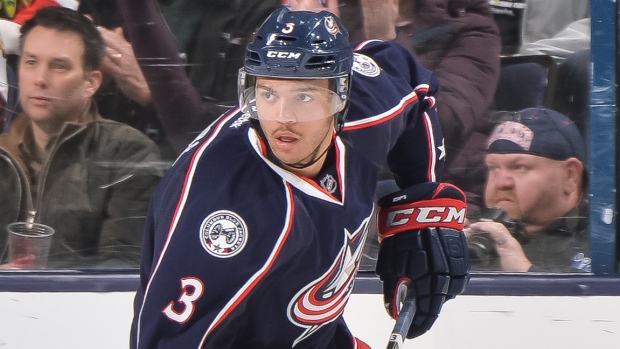Sep 27, 2018
Jones injury a major blow to Blue Jackets
Columbus will start the season without a defenceman who has proven he drives goals and wins for his team, Travis Yost writes.
By Travis Yost

The Columbus Blue Jackets have been dealt a huge blow just one week before the opening of the regular season.
Defenceman Seth Jones injured his knee in Tuesday’s preseason win over the Buffalo Sabres and the diagnosis came back with what the team feared – a ligament injury that will sideline their star for at least four to six weeks.
The Jones news couldn’t have possibly come at a worse time. The Blue Jackets window feels very short-term – it’s a team that is loaded with talent, but has a number of off-ice issues looming over the organization. Artemi Panarin and Sergei Bobrovsky, arguably two of the team’s best players last season, are in the final year of their contracts. Negotiations with both players are reported to be at an impasse, and for now the Blue Jackets will have to march forward with little long-term clarity into either situation.
Those issues will need to be managed by the front office over time. The Jones injury is a different animal – one that the coaching staff and organization need to deal with right away. Jones has come a long way from being selected fourth overall in the 2013 NHL Draft. He took a massive step forward during the 2017-18 season, where he and teammate Zach Werenski united to create one of the best duos in the National Hockey League. In TSN’s 50 Player ranking, Jones was graded as the 30th best player in the league. (Werenski went unranked.)
It’s difficult to tease out which of the two players is really driving the bus since Jones and Werenski play together so frequently. What makes it even more challenging is that it doesn’t need to be one player or the other. Sometimes, two guys just complement each other well and together have a sizable impact on team performance.
What we do know though is that Columbus benefited hugely from having Jones on the ice. He is a mega-talented skater who has always been crafty with the puck on his stick and has impressive ability to transition play through the neutral zone quickly. But he’s also developed in the defensive zone – he’s quick enough to avoid getting beat on the outside and strong enough to defend within the interior.
Not surprisingly, Columbus realizes a substantial territorial advantage with Jones on the ice. But what’s noteworthy is how Jones (and, by extension, Columbus’ first pairing) really boost the numbers of the players around them.
If you look at shot differentials, you can see that the Blue Jackets play an awful lot more in the offensive zone when Jones is on the ice. He can move around the lineup and have a similar impact. But the teammates who move away from Jones see substantial territorial degradation:
What should be obvious here is how much players missed playing with Jones. Whereas Jones consistently saw possession rates well in excess of 50 per cent (which we would consider average or break-even performance) regardless of who he played with, the majority of Jackets skaters saw considerable declines in possession when skating with defencemen other than Jones.
It’s also obvious that when Jones is paired with similarly talented skaters the results are exceptional. You’ll note that when Jones played with guys like Artemi Panarin, Pierre-Luc Dubois, and Josh Anderson, Columbus possession rates sat between 56 and 58 per cent, which is stunning.
What made the Blue Jackets so dangerous last season was that their top unit – their top line playing with their top pairing – was one of the best in the National Hockey League. That was true if you were measuring performance by possession, scoring chances or goal differential.
These are the exact type of performance boosts we see year in and year out from elite defencemen. The true top tier of defencemen – think Erik Karlsson, Victor Hedman and Drew Doughty – consistently push play into the offensive third, and over time that correlates awfully well with driving advantageous goal differentials. One underrated piece of driving play the way a player like Jones does? You can avoid ugly, extended slumps when the puck isn’t the bouncing the right way – at either end of the ice.
Jones obviously lived in the offensive zone last year and threw much more robber at the opposing goaltender than Bobrovsky saw behind him. Did it drive goals and wins into the standings for Columbus? In one word: yes.
By season’s end, Columbus saw 246 more shots and 15 more goals than their opponents with Jones on the ice. For comparison’s sake, here are the same numbers for last year’s Norris Trophy winner: 131 more shots and 26 more goals for the Tampa Bay Lightning. Jones isn’t Hedman, but he may not be far behind.
Jones is a sensational talent. Replacing him, even if it’s just for one month, is going to be awfully difficult for the Blue Jackets. It will surely mean a bigger burden for the talented Werenski. David Savard and Ryan Murray will also likely see sizable minute increases.
The rest of the team will wait, patiently, for Jones to return.


